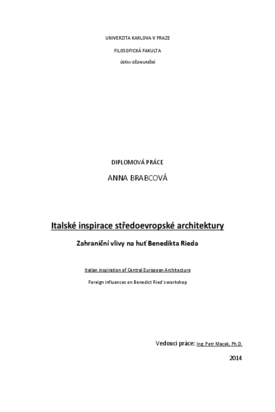Italské inspirace středoevropské architektury
Italian inspiration of middle european architecture
diplomová práce (OBHÁJENO)

Zobrazit/
Trvalý odkaz
http://hdl.handle.net/20.500.11956/67343Identifikátory
SIS: 122847
Katalog UK: 990019366640106986
Kolekce
- Kvalifikační práce [24991]
Autor
Vedoucí práce
Oponent práce
Biegel, Richard
Fakulta / součást
Filozofická fakulta
Obor
Dějiny umění
Katedra / ústav / klinika
Ústav pro dějiny umění
Datum obhajoby
4. 2. 2015
Nakladatel
Univerzita Karlova, Filozofická fakultaJazyk
Čeština
Známka
Dobře
Klíčová slova (česky)
Renesance, architektura, edikuly, Čechy, Praha, Pražský hrad, Vladislav II. Jagellonský, Benedikt Ried, Uhry, Budín, Matyáš Korvín, Beatrice Aragonská z Neapole, Giovanni Dalmata, Chimenti Camicia, Itálie, Urbino, Federico da Montefeltro, Luciano Laurana, Francesco di Giorgio MartiniKlíčová slova (anglicky)
Renaissance, architecture, aedicula, Bohemia, Prague, Prague Castle, Vladislaus II. Jagiello, Benedikt Ried, Hungary, Buda, Matthias Corvinus, Beatrice of Aragon from Naples, Giovanni Dalmata, Chimenti Camicia, Italy, Urbino, Federico da Montefeltro, Luciano Laurana, Francesco di Giorgio MartiniNa konci 15. století na území Čech proniká renesanční tvarosloví, které se roku 1493 objevuje i na Pražském hradě v podobě oken Vladislavského sálu Starého královského paláce. Jejich podoba je historicky i stylově spjata s Budínským hradem, kam roku 1490 Vladislav II. Jagellonský přesídlil. Zde se setkal s prvotřídní tvorbou dvora Matyáše Korvína, pro nějž pracovali italští mistři. Vzory fragmentů oken nalezených v Budíně pak lze hledat na Palazzu Ducale Federica da Montefeltro v Urbinu, neboť Uhry byly díky královně Beatrici Aragonské z Neapole v živém kontaktu s Itálií.
At the end of the 15th century in Bohemia penetrates the Renaissance style, which appeared in 1493 at the Prague Castle in the form of windows of the Vladislav Hall in the Old Royal Palace. Their appearance is historically and stylistically linked to the Buda Castle, where Vladislaus II. Jagiello relocated in 1490. Here he met the prime marble carvings of the court of Matthias Corvinus, for which worked Italian masters. Patterns of fragments of windows founded in Buda can find at the Palazzo Ducale of Federico da Montefeltro in Urbino, because Hungary was due Queen Beatrice of Aragon from Naples in live contact with Italy.
